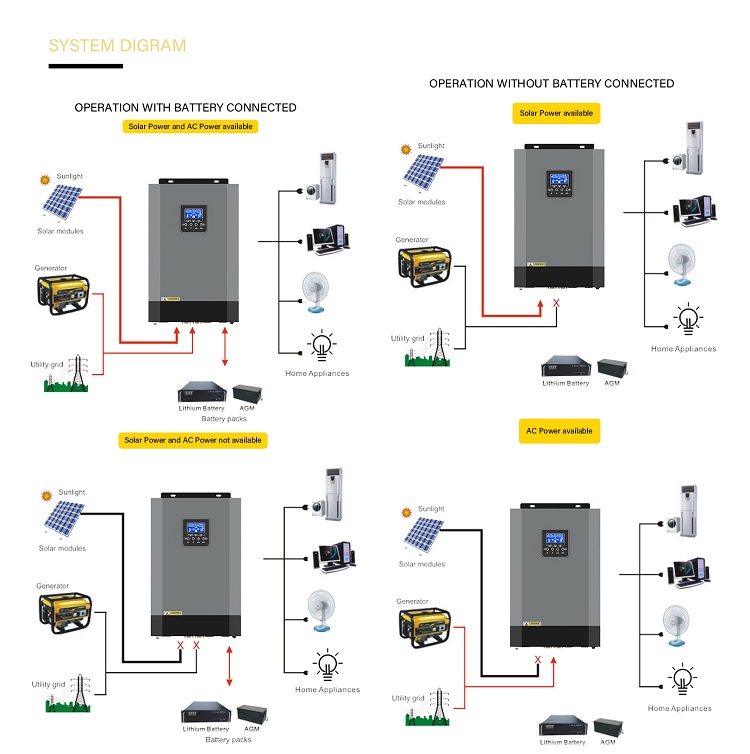Solar photovoltaic systems are divided into off-grid photovoltaic power generation systems, grid-connected photovoltaic power generation systems and distributed photovoltaic power generation systems:
1. Off-grid photovoltaic power generation system. It is mainly composed of solar cell components, controllers, and batteries. To supply power to the AC load, an AC inverter needs to be configured.
2. The grid-connected photovoltaic power generation system is that the direct current generated by the solar modules is converted into alternating current that meets the requirements of the mains grid through the grid-connected inverter, and then directly connected to the public grid. The grid-connected power generation system has centralized large-scale grid-connected power stations, which are generally national-level power stations. However, this kind of power station has not developed much due to its large investment, long construction period and large area. The decentralized small grid-connected power generation system, especially the photovoltaic building-integrated power generation system, is the mainstream of grid-connected power generation due to its advantages of small investment, fast construction, small footprint, and strong policy support.
3. Distributed photovoltaic power generation system, also known as distributed power generation or distributed energy supply, refers to the configuration of a smaller photovoltaic power generation power supply system at the user site or near the power site to meet the needs of specific users and support the existing distribution network. economic operation, or meet the requirements of both aspects at the same time.
The basic equipment of the distributed photovoltaic power generation system includes photovoltaic cell modules, photovoltaic square array supports, DC combiner boxes, DC power distribution cabinets, grid-connected inverters, AC power distribution cabinets and other equipment, as well as power supply system monitoring devices and environmental monitoring devices. device. Its operation mode is that under the condition of solar radiation, the solar cell module array of the photovoltaic power generation system converts the output electric energy from solar energy, and sends it to the DC power distribution cabinet through the DC combiner box, and the grid-connected inverter converts it into AC power supply. The building itself is loaded, and excess or insufficient electricity is regulated by connecting to the grid.
working principle:
During the daytime, under the condition of illumination, the solar cell components generate a certain electromotive force, and the solar cell square array is formed through the series and parallel connection of the components, so that the square array voltage can meet the requirements of the system input voltage. Then, the battery is charged through the charge and discharge controller, and the electric energy converted from the light energy is stored. At night, the battery pack provides the input power for the inverter, and through the function of the inverter, the DC power is converted into AC power, which is sent to the power distribution cabinet, and the power is supplied by the switching function of the power distribution cabinet. The discharge of the battery pack is controlled by the controller to ensure the normal use of the battery. The photovoltaic power station system should also have limited load protection and lightning protection devices to protect the system equipment from overload operation and avoid lightning strikes, and maintain the safe use of system equipment.
System Features:
Advantage
1. Solar energy is inexhaustible, and the solar radiation received by the earth’s surface can meet 10,000 times the global energy demand. As long as solar photovoltaic systems are installed on 4% of the world’s deserts, the electricity generated can meet the needs of the world. Solar power generation is safe and reliable, and will not suffer from energy crises or fuel market instability;
2. Solar energy is available everywhere, and can supply power nearby, without long-distance transmission, avoiding the loss of long-distance transmission lines;
3. Solar energy does not require fuel, and the operating cost is very low;
4. There are no moving parts for solar power generation, it is not easy to be damaged, and the maintenance is simple, especially suitable for unattended use;
5. Solar power generation will not produce any waste, no pollution, noise and other public hazards, no adverse impact on the environment, is an ideal clean energy;
6. The solar power generation system has a short construction period, is convenient and flexible, and can arbitrarily add or reduce the amount of solar energy according to the increase or decrease of the load to avoid waste.
Shortcoming
1. The ground application is intermittent and random, and the power generation is related to the climatic conditions. It cannot or rarely generates power at night or in cloudy and rainy days;
2. The energy density is low. Under standard conditions, the solar radiation intensity received on the ground is 1000W/M^2. When used in large sizes, it needs to occupy a large area;
3. The price is still relatively expensive, 3 to 15 times that of conventional power generation, and the initial investment is high.
Post time: Sep-08-2022






